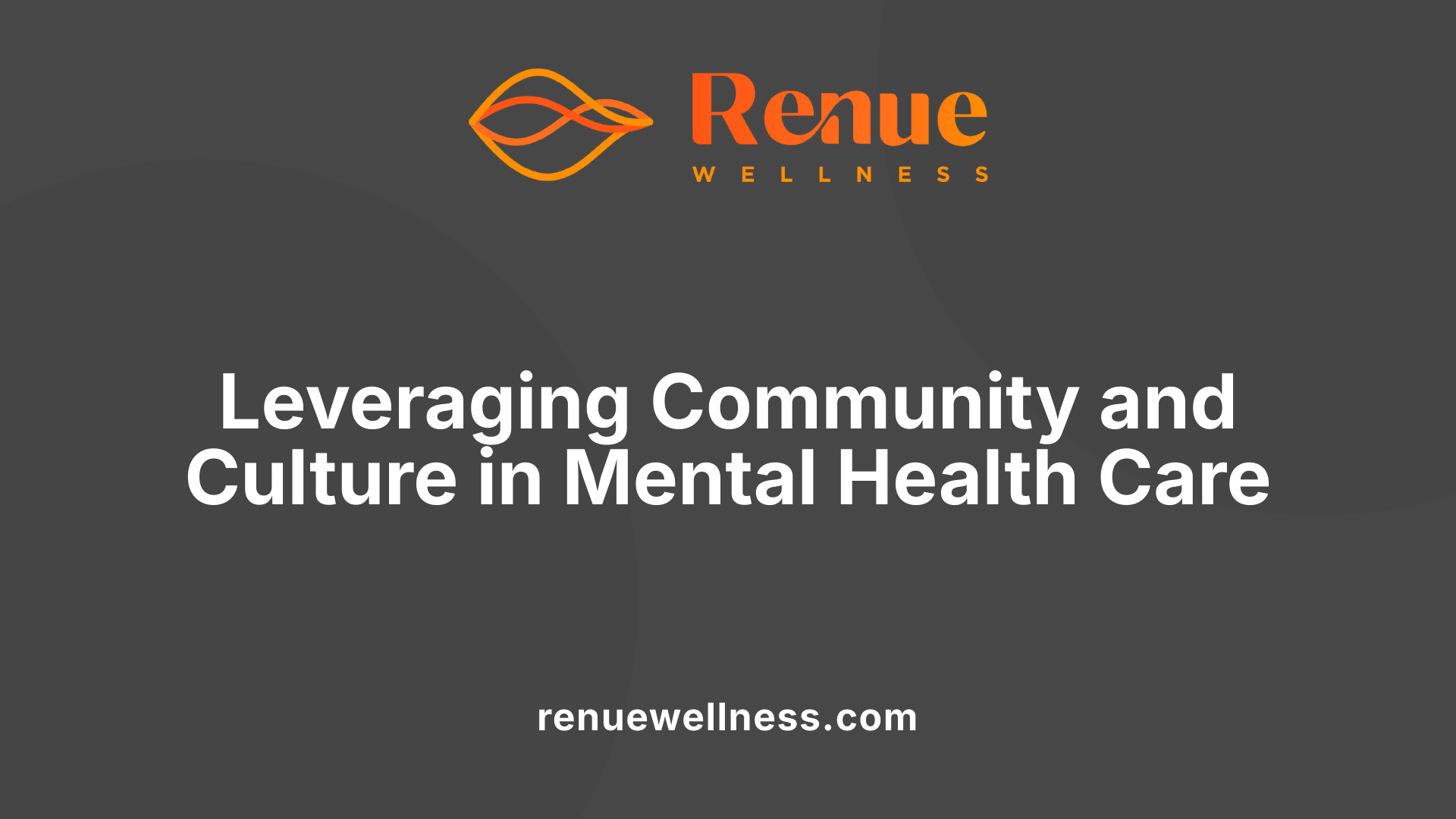Mental Health Challenges in Immigrant Communities: The Role of Ketamine


July 21, 2025
Understanding the Complex Landscape of Immigrant Mental Health
Immigrant communities face a multifaceted set of mental health challenges shaped by their migration journeys, societal attitudes, and systemic barriers. These challenges require nuanced, culturally competent strategies and innovative treatments like ketamine to bridge the gaps in care and improve outcomes.
The Phases of Migration and Mental Health Impact

What are the common mental health challenges faced by immigrant communities?
Immigrant communities face numerous mental health challenges that are shaped by their unique migration experiences. These difficulties often stem from exposure to pre-migration trauma, such as violence, torture, or famine, which can leave lasting psychological scars like PTSD, depression, and anxiety.
During migration, many experience additional stressors including dangerous journeys, separation from loved ones, and uncertainty about their future. These cumulative stressors increase the risk of mental health issues. Once settled in a new country, immigrants often encounter barriers like language difficulties, cultural differences, and social isolation. These obstacles hinder access to mental health services and contribute to ongoing distress.
Refugees and recent immigrants are especially vulnerable. Their experiences of forced migration, combined with challenges in adapting to a new environment, can lead to higher incidences of psychiatric disorders. Family separation and restrictive policies exacerbate these issues, leading to feelings of hopelessness and marginalization.
Furthermore, stigma surrounding mental health within some cultures discourages individuals from seeking help. Lack of culturally competent mental healthcare, combined with systemic barriers such as high costs, lack of insurance, and limited interpreter services, worsens the situation.
Addressing these mental health challenges requires a comprehensive approach that considers all stages of migration. Interventions should focus on reducing barriers to care, promoting community support, and providing culturally sensitive mental health resources tailored to the needs of immigrant populations.
| Migration Phase | Key Risks | Impacts on Mental Health | Support Strategies |
|---|---|---|---|
| Premigration | Violence, trauma, famine | PTSD, depression, anxiety | Trauma-informed care, community outreach |
| Migration | Dangerous journey, family separation | Acute stress, fear, grief | Legal assistance, social support networks |
| Postmigration | Language barriers, discrimination, social isolation | Chronic stress, untreated mental illness | Culturally competent care, language services, community engagement |
Understanding these stages helps in creating targeted interventions that alleviate suffering and promote mental well-being among immigrant communities.
Distinct Risk Factors During Migration
What factors contribute to mental health issues among immigrant populations?
Immigrant populations face a complex array of challenges that significantly impact their mental health. These challenges begin well before migration, with many experiencing adverse events such as violence, torture, war, or natural disasters in their native countries. Exposure to such trauma increases vulnerability to conditions like post-traumatic stress disorder (PTSD), depression, and anxiety.
The migration journey itself often involves forced displacement, perilous travels, or detention, all of which can exacerbate psychological distress. Refugees, in particular, are at heightened risk due to exposure to violence, torture, and family separation, which have long-lasting mental health effects.
Post-migration, additional stressors include poverty, discrimination, language barriers, and difficulties adapting to new cultural environments. Limited access to healthcare, legal uncertainties, and fears of deportation also contribute to mental health problems.
Children and adolescents are especially vulnerable, with risks amplified by disrupted education and social networks. Older adults may experience cultural isolation and traditional health syndromes that hinder access to appropriate care.
Several protective factors can mitigate these risks. Strong social support, community engagement, positive ethnic identity, and cultural continuity serve as buffers against mental health deterioration. Conversely, stigma around mental health and systemic barriers in healthcare access often discourage immigrants from seeking help.
To address these issues, culturally competent mental health services tailored to the unique experiences of immigrant groups are essential. Community outreach, policies promoting social inclusion, and efforts to reduce discrimination are vital in supporting mental well-being.
| Trauma Type | Impact on Mental Health | Population Affected | Additional Notes |
|---|---|---|---|
| Violence & Torture | Elevated PTSD, depression | Refugees, Torture survivors | Long-lasting emotional scars |
| Forced Migration | Anxiety, chronic stress | All migrant groups | Displacement trauma |
| Detention & Separation | Anxiety, depression, PTSD | Refugees, Detained migrants | Emotional trauma persists post-release |
Understanding these interconnected factors emphasizes the need for a holistic approach to mental health for immigrants. Addressing trauma at every migration phase — premigration, migration, and postmigration — is crucial for fostering resilience and improving outcomes.
Postmigration Stressors and Mental Health Outcomes
How do socioeconomic hardships, discrimination, and legal insecurity influence mental health in immigrant populations?
Immigrants often encounter significant challenges after arriving in their new countries. Socioeconomic hardships such as poverty, unemployment, and poor housing conditions are common issues that contribute to stress and mental health problems. These conditions can lead to feelings of insecurity and hopelessness, which heighten the risk for depression and anxiety.
Discrimination and prejudice are also prevalent in many immigrant communities. Experiences of racism, cultural bias, and social exclusion are linked to increased incidences of depression, PTSD, and other mental health disorders. Discriminatory acts not only cause emotional distress but can also deter individuals from seeking necessary mental health services due to distrust or fear.
Legal insecurity, including fears of deportation and uncertainty about immigration status, adds another layer of stress. Policies that limit access to health care, social services, and employment opportunities create a persistent sense of marginalization and frustration. These feelings can lead to chronic anxiety, despair, and feelings of social isolation.
Impact of Social Support and Community: Social support, especially from family, friends, and community networks, plays a crucial protective role. Strong community ties and cultural familiarity can buffer against the negative effects of postmigration stressors.
Conversely, social exclusion and systemic barriers—exacerbated by restrictive immigration policies—intensify psychological distress. For example, policies that hinder access to health insurance, legal protections, or employment opportunities can deepen feelings of alienation.
Role of Immigration Policies: Immigration laws and policies influence mental health outcomes by either facilitating integration or fostering marginalization. Policies that restrict access to education, healthcare, and legal support often lead to feelings of uncertainty and loss of control.
Restrictive policies, such as the Public Charge rule, discourage reliance on public benefits, including mental health services, further enlarging disparities. The socio-political environment also impacts mental health; anti-immigrant rhetoric and policies increase mistrust and perceived threat, especially among refugees and undocumented immigrants.
Broader Influences: Other factors like neighborhood ethnic density, language proficiency, and trauma history modify postmigration stress impacts. For instance, living in ethnically dense neighborhoods may offer social comfort, whereas language barriers can hinder access to services and social integration.
In conclusion, socioeconomic hardships, discrimination, and legal insecurity significantly influence mental health outcomes in immigrant populations. Supportive environments and inclusive policies can promote resilience and reduce mental health disparities.
Cultural Influences and Barriers in Mental Healthcare
How do cultural beliefs and stigma influence mental health treatment in immigrant populations?
Cultural beliefs and stigma play a significant role in shaping how immigrant populations perceive and access mental health care. Many cultures associate mental illness with shame, weakness, or moral failure, which discourages individuals from seeking help due to fear of social exclusion or dishonor. This internalized stigma can lead to silence, denial, or reluctance to discuss mental health issues openly.
Moreover, different cultural explanations of mental health—such as viewing symptoms through spiritual or holistic lenses—may influence how individuals interpret their experiences. For example, some communities might see mental health problems as spiritual punishments or curses, favoring traditional or community-based remedies over formal psychiatric treatment.
Language barriers exacerbate these challenges, making it harder for immigrants to communicate symptoms accurately and trust healthcare providers. Mistrust of providers unfamiliar with cultural norms and fears of discrimination can further deter engagement.
Addressing these barriers requires culturally sensitive approaches that respect and incorporate cultural beliefs. Providing education tailored to specific cultural contexts, training clinicians in cultural competence, and building trust with community leaders are essential steps towards effective treatment.
By recognizing and adapting to culturally rooted perceptions, healthcare systems can reduce stigma, improve help-seeking behavior, and promote better mental health outcomes among immigrant communities.
The Role of Ketamine in Mental Health Treatment for Immigrants
What is the role of innovative treatments like ketamine in addressing mental health issues in immigrant communities?
Immigrant communities often face prolonged barriers to accessing traditional mental health services, including language difficulties, stigma, and systemic obstacles. As a result, many suffer from untreated depression, anxiety, and treatment-resistant conditions. Innovative treatments like ketamine have emerged as promising options to bridge this gap.
Ketamine is known for its rapid antidepressant effects. Unlike conventional antidepressants that may take weeks to become effective, ketamine can start alleviating symptoms within hours after administration. This quick response can be particularly beneficial in urgent cases, such as severe depression or suicidal ideation, which are common among immigrant populations dealing with acculturation stress, trauma, and systemic challenges.
Research indicates that ketamine is especially useful for treatment-resistant depression—an area where many immigrant patients often struggle due to ongoing barriers to sustained care. Its ability to quickly reset neural circuits offers hope for individuals who have not responded to other treatments.
The safety and efficacy of ketamine treatment are supported by numerous studies. Short-term use has been associated with significant symptom reduction, and repeated infusions can prolong benefits. Nevertheless, potential risks include the development of dependency, bladder issues, and cognitive effects, emphasizing the importance of careful monitoring.
While ketamine is not a cure-all, it holds the potential to serve as a valuable adjunct in a comprehensive, culturally sensitive treatment plan. When integrated with community support, mental health education, and accessible follow-up care, ketamine can help address urgent mental health needs among immigrants, facilitating their stabilization and integration into mental health treatment pathways.
Scientific Evidence on Ketamine’s Effectiveness and Safety
What does scientific research say about the efficacy and safety of ketamine for treating mental health issues among immigrants?
Research into ketamine treatment shows it has a rapid and potent effect on alleviating symptoms of depression and anxiety. Many studies demonstrate that patients often experience relief within hours after receiving ketamine, with improvements sometimes lasting for several weeks, especially after repeated doses. This makes ketamine a promising option for individuals facing severe or treatment-resistant mental health conditions.
In terms of safety, the overall profile of ketamine is considered acceptable when administered appropriately. Common mild side effects include dissociation, nausea, dizziness, and elevated blood pressure, which tend to resolve quickly after treatment. Serious adverse events are rare, but ongoing monitoring is essential to ensure patient safety.
Several studies from different clinical settings, including surgical anesthesia and palliative care, support ketamine’s effectiveness. Despite these positive findings, long-term safety and effectiveness data are limited. Most research focuses on short-term outcomes, and more studies are needed to understand the potential risks of repeated or prolonged use.
Importantly, the neurobiological mechanisms behind ketamine's rapid antidepressant effects involve changes in brain connectivity and neurotransmitter activity, particularly glutamate pathways. These insights help explain why ketamine can produce quick symptom relief, distinguishing it from traditional antidepressants that often take weeks to work.
Despite the promising results, there is a notable gap in research specifically targeting immigrant populations. Existing studies do not provide sufficient data on how ketamine works across different cultural backgrounds, including potential differences in response or side effects. Further, ethical and safe implementation within culturally diverse contexts requires tailored approaches.
In summary, scientific evidence supports ketamine as an effective and generally safe treatment for acute depression and anxiety, with rapid onset of effects. However, comprehensive long-term safety profiles and culturally sensitive research focused on immigrant groups are necessary before it can be widely recommended. Continued investigation will help determine how best to incorporate ketamine into mental health care for these vulnerable populations.
Benefits and Risks of Ketamine Therapy for Immigrants
What are the potential benefits and risks of ketamine therapy for immigrant populations?
Ketamine therapy has gained attention as a fast-acting treatment option for some mental health conditions, especially treatment-resistant depression and certain chronic pain disorders.
For immigrant populations, who often face barriers to accessing traditional mental health services, ketamine offers a potential for rapid symptom relief. This can be especially valuable during acute episodes of depression or trauma-related symptoms, helping individuals regain stability while they navigate other aspects of resettlement.
Despite these advantages, there are important risks involved. Common side effects during treatment include dissociation, hallucinations, elevated blood pressure, and nausea. While these often resolve shortly after treatment, their occurrence can be distressing, particularly without proper support.
Long-term effects are less well understood. Concerns include possible cognitive impairments, bladder damage, and the risk of dependence or misuse. This is especially pertinent for vulnerable groups who may misunderstand the treatment or lack access to thorough follow-up care.
Regulatory oversight varies globally, with some clinics offering unregulated or poorly supervised treatments. Such gaps raise worries about inadequate patient assessments, insufficient monitoring during therapy, and the potential for exploitation, which can disproportionately burden immigrant groups already facing systemic barriers.
Cultural and language differences further complicate informed consent and understanding of treatment risks. Immigrants may struggle to fully grasp the implications of treatment if communication is not culturally sensitive or available in their native language.
Therefore, implementing ketamine therapy for immigrants should involve careful medical evaluation, culturally competent communication, and ongoing supervision. These steps are crucial to maximize potential benefits while minimizing adverse outcomes, ensuring that this promising treatment aligns with the needs and safety of diverse populations.
Cultural Beliefs, Stigma, and Mental Health Treatment
How do cultural beliefs and stigma influence mental health treatment in immigrant populations?
In many immigrant communities, cultural perceptions of mental illness play a significant role in shaping how individuals understand and approach mental health issues. These beliefs often include spiritual explanations, traditional remedies, or holistic views, which influence symptom expression and help-seeking behaviors.
Stigma associated with mental health is pervasive in numerous cultures. It can cause feelings of shame, embarrassment, or fear, leading many to hide their struggles or avoid seeking help altogether. This internalized stigma discourages open discussion about mental health problems, contributing to delays in diagnosis and treatment.
Traditional remedies and community-based approaches are frequently preferred over formal mental health services. For example, some communities rely on spiritual leaders, family, or traditional healers, often due to mistrust of healthcare providers who lack cultural competence or due to language barriers.
The combined effect of cultural beliefs and stigma results in underutilization of mental health resources among immigrants. Barriers such as fear of discrimination, concern about preserving family or community reputation, and unfamiliarity with healthcare systems further hinder engagement.
Addressing these challenges requires culturally sensitive interventions. Building trust through culturally competent care, integrating traditional practices when appropriate, and providing education about mental health can help reduce stigma. Outreach efforts involving community leaders and language-appropriate resources are vital to improve mental health outcomes for immigrant populations.
Ensuring mental health services respect cultural norms and beliefs, while promoting awareness and acceptance, is key to overcoming barriers and encouraging timely help-seeking.
Strategies to Enhance Access and Cultural Competency
What strategies can improve access to mental health care and treatments like ketamine for immigrants?
To ensure immigrants and refugees receive adequate mental health care, including innovative treatments like ketamine therapy, a multifaceted approach is necessary. Engagement begins with community outreach and education, which aims to raise awareness about available services, demystify treatment options, and reduce the stigma surrounding mental health issues. Tailored educational campaigns in multiple languages and culturally relevant formats can make a significant difference.
Expanding interpreter services is also crucial. This involves securing funding to provide professional interpreters, training healthcare staff on best practices for working with interpreters, and developing programs that are linguistically responsive. Such efforts help mitigate language barriers that often lead to misdiagnoses, delayed care, or treatment dropout.
Healthcare systems should also advocate for policy reforms that promote equitable access. This includes extending coverage for mental health services to uninsured or underinsured populations, integrating mental health care within primary care settings, and ensuring affordability for treatments like ketamine. These measures can particularly benefit vulnerable groups who face systemic obstacles.
Building strong community support networks is fundamental. Trusted community organizations, religious groups, and social clubs can provide social support, facilitate referrals, and foster environments of trust. These networks help combat discrimination and social isolation, which are detrimental to mental health.
Finally, addressing broader social determinants such as stable housing, employment opportunities, and legal security can significantly reduce post-migration stressors. When social conditions improve, overall access to mental health treatments becomes more effective, and treatment outcomes are more positive.
Implementing these strategies is vital in bridging gaps in mental health care for immigrant populations, ensuring that everyone has the opportunity to benefit from comprehensive, culturally sensitive treatments.
The Importance of Culturally Tailored Interventions and Education
How can mental health services be tailored to better serve immigrant populations?
To improve mental health outcomes among immigrant groups, services must be culturally sensitive and adapted to meet specific community needs. Culturally tailored treatment models consider the unique cultural values, beliefs, and traditional practices of different immigrant communities. Incorporating culturally accepted healing methods, when appropriate, helps make treatment more relevant and acceptable.
Providing language-concordant care is vital—employing clinicians who speak the native languages of clients or utilizing professional interpreters ensures clear communication and fosters trust. In addition to language skills, clinicians should undergo cultural competence training to better understand and respect diverse cultural norms, help-seeking behaviors, and expressions of mental health symptoms.
Community engagement is crucial for successful outreach. Involving local leaders, religious figures, and cultural organizations in mental health promotion helps to reduce stigma and promote awareness. Educational initiatives aimed at increasing mental health literacy—such as workshops, informational campaigns, and community-based programs—can dispel misconceptions and inform individuals about symptoms, treatments, and how to seek help.
Collaborative care approaches that respect cultural norms and actively involve community members create a supportive environment. This increases treatment engagement, adherence, and ultimately leads to better mental health outcomes.
| Cultural Customization | Strategies | Benefits |
|---|---|---|
| Traditional practices integration | Including accepted cultural healing methods | Increased acceptance and trust in treatment |
| Language support | Employing bilingual staff or interpreters | Clearer communication and comfort |
| Cultural competence training | Educating clinicians about community norms | Improved understanding and sensitivity |
| Community involvement | Partnering with local leaders and organizations | Greater outreach and trust |
| Educational campaigns | Mental health literacy initiatives | Reduced stigma and increased awareness |
By implementing such tailored strategies, mental health services become more accessible and effective for diverse immigrant populations, promoting better overall well-being.
The Potential Role of Ketamine in Treating Treatment-Resistant Depression in Immigrants
What is the role of innovative treatments like ketamine in addressing mental health issues in immigrant communities?
Immigrant populations often face numerous barriers that hinder access to traditional mental health services, including language difficulties, cultural stigma, limited insurance coverage, and distrust of healthcare providers. As a result, many individuals with severe depression or treatment-resistant conditions do not receive adequate care.
Ketamine, an anesthetic with rapid antidepressant properties, offers a promising alternative. When administered via infusion, ketamine can produce significant relief from depressive symptoms within hours, a stark contrast to conventional antidepressants that may take weeks to become effective. This quick action is especially vital for immigrants experiencing acute crises or severe symptoms that impair daily functioning.
While the initial effects of ketamine are often temporary, repeated infusion sessions over a short course can help sustain mood improvements and lower the risk of relapse. This feature is particularly beneficial for immigrant communities, where ongoing engagement with healthcare services may be limited.
However, there are concerns regarding the long-term safety of ketamine, including potential for dependence, bladder issues, and other side effects, which necessitate cautious and closely monitored use. Its integration into mental health care for immigrants must be accompanied by culturally sensitive practices and supportive services to maximize benefits.
Overall, ketamine serves as a valuable adjunct in a comprehensive treatment plan, potentially bridging gaps in care and providing rapid relief for those who might otherwise remain untreated due to systemic barriers.
Research Evidence Supporting Ketamine Use in Immigrants
What does scientific research say about the efficacy and safety of ketamine for treating mental health issues among immigrants?
Current scientific evidence suggests that ketamine offers rapid and notable symptom relief for various mental health conditions, particularly depression and anxiety. Many studies demonstrate that after a single or multiple doses, patients often experience significant improvement within hours, a quick onset of effect that is especially valuable for individuals suffering severe symptoms.
The effects of ketamine can last for several weeks, especially when combined with ongoing therapy or additional doses, making it a promising option for immediate symptom management. Importantly, research indicates that ketamine is generally safe and well tolerated in diverse patient groups. Its typical side effects are mild and transient, including feelings of dissociation, nausea, dizziness, and mild cardiovascular changes. Serious adverse events are rare but require careful monitoring.
Safety profiles from studies in perioperative and palliative care settings reinforce its acceptable risk balance when administered under medical supervision. However, long-term safety and efficacy data are limited, and further investigations are necessary to understand potential risks associated with repeated or maintenance use.
The neurobiological action of ketamine involves modulating brain connectivity and neurotransmitter systems, such as glutamate, which contributes to its rapid antidepressant effects. This mechanism is particularly promising for populations with treatment-resistant depression.
Despite these positive findings, research specifically targeting immigrant populations remains scarce. The cultural, linguistic, and systemic barriers faced by immigrants can influence treatment outcomes and acceptability. Therefore, more focused studies are needed to evaluate how ketamine therapy can be effectively integrated into culturally sensitive mental health care for immigrant groups. Ultimately, rigorous research tailored to these populations will help determine its appropriateness, optimize protocols, and ensure safe, equitable access.
Balancing Benefits and Risks of Ketamine Therapy
What are the potential benefits and risks of ketamine therapy for immigrant populations?
Ketamine therapy has gained attention as an innovative treatment option, especially for individuals suffering from treatment-resistant depression and chronic pain conditions. For immigrant populations, who often encounter barriers to accessing traditional mental health care, ketamine offers the possibility of rapid symptom relief. This can be particularly beneficial in settings where long waitlists or cultural stigma hinder timely intervention.
However, the use of ketamine also carries significant risks. Common immediate side effects include dissociation, hallucinations, increased blood pressure, and nausea during or following treatment sessions. These effects can be distressing and may require medical management.
Long-term concerns are less well understood but are increasingly recognized. Potential issues include cognitive impairment, dependency, and bladder damage, particularly if the drug is misused or obtained outside regulated medical environments.
Vulnerable groups, such as recent immigrants or those with limited health literacy, face additional challenges. Lack of regulation in some clinics raises fears of inadequate patient screening, insufficient monitoring, and exploitation. Cultural and language differences can impair understanding of treatment risks and benefits, complicating informed consent and post-treatment follow-up.
To maximize benefits and reduce risks, ketamine therapy should be administered under strict medical supervision, with comprehensive assessments prior to treatment. Culturally sensitive communication is crucial to ensure patients fully understand the procedure, potential side effects, and the importance of follow-up care.
Overall, while ketamine may offer promising relief for certain mental health conditions within immigrant communities, careful regulation, cultural competence, and ongoing research are vital to ensure safe and effective use.
Cultural Beliefs, Trauma, and Help-Seeking Behaviors
How do cultural beliefs and stigma influence mental health treatment in immigrant populations?
Cultural beliefs and stigma play crucial roles in shaping how immigrant populations perceive and engage with mental health care. Many cultures have specific views about mental illness, often emphasizing spiritual, holistic, or community-based explanations rather than biomedical models. For example, some communities see mental health issues as a result of spiritual imbalance, moral failure, or external evil influences. These beliefs can influence individuals to seek traditional healing practices, spiritual interventions, or rely on community and religious leaders instead of formal healthcare providers.
Stigma surrounding mental illness significantly impacts help-seeking behaviors. In many immigrant communities, mental health problems are associated with shame, weakness, or dishonor. This negative perception discourages individuals from discussing their symptoms openly or pursuing treatment, leading to delays and untreated mental health conditions. Fear of discrimination or social rejection may result in concealment of symptoms, and in some cases, individuals may avoid seeking help altogether to preserve family or community reputation.
The reluctance to seek formal treatment is often compounded by language barriers, mistrust of healthcare systems unfamiliar to their cultural norms, and fears of being misunderstood or marginalized by providers. Additionally, systemic issues like limited access to culturally competent mental health services further discourage engagement.
To address these barriers, mental health services need to be culturally sensitive and adapted to incorporate individuals' spiritual and cultural beliefs. Building trust between healthcare providers and immigrant communities through culturally competent care, community outreach, and engagement of cultural leaders can foster better understanding and acceptance of mental health treatment.
Effective strategies include training providers in cultural competence, providing interpreter services, and integrating traditional healing practices where appropriate. These efforts can reduce stigma, improve trust, and encourage more immigrant individuals to seek timely, appropriate care.
In sum, understanding and respecting cultural beliefs, alongside reducing stigma, are essential steps toward improving mental health outcomes for immigrant populations.
Innovations in Mental Health Care: Culturally Sensitive Approaches and Community Engagement
How can mental health services be tailored to better serve immigrant populations?
To effectively serve immigrant populations, mental health services must adapt to meet their cultural and linguistic needs. Culturally tailored treatment models involve integrating traditional healing practices alongside conventional therapy, respecting cultural beliefs about health and illness. Providing language-concordant care is crucial—using trained interpreters or employing bilingual clinicians helps bridge communication gaps.
Training clinicians in cultural competence is essential to reduce misunderstandings and build trust. They learn to recognize culturally specific symptoms and expressions of mental health issues, enabling more accurate diagnoses and personalized care.
In addition, mental health literacy initiatives aim to improve understanding of mental health within immigrant communities. These programs focus on normalizing mental health discussions, reducing stigma, and dispelling misconceptions about treatment options.
Building community trust is further supported by involving local leaders, religious figures, and cultural organizations in outreach efforts. These trusted figures serve as bridges, encouraging community members to seek help without fear or shame.
Collaborative approaches foster respectful engagement with cultural norms, integrating community insights with clinical practices. This results in higher treatment participation, better adherence to therapies, and improved overall mental health outcomes.
How can community engagement be enhanced?
Community engagement strategies include hosting culturally sensitive workshops, creating multilingual educational materials, and setting up peer support networks. These initiatives make mental health resources accessible and relatable.
Outreach efforts led by community and religious leaders can effectively address stigma and promote mental health awareness. Employing community health workers from within immigrant groups ensures messaging resonates and barriers are minimized.
Research and policy reforms are needed to support these initiatives, emphasizing the importance of community-centered care. Overall, fostering strong partnerships with cultural organizations, faith groups, and trusted community figures can significantly improve mental health care access and quality for immigrant populations.
The Promise of Ketamine in Bridging Treatment Gaps, Especially During a Pandemic
What is the role of innovative treatments like ketamine in addressing mental health issues in immigrant communities?
Immigrant communities often face significant barriers to accessing traditional mental health care, including language differences, stigma, lack of culturally competent providers, and systemic obstacles such as insurance and cost. These challenges are compounded during crises, such as the COVID-19 pandemic, which has increased mental health issues across populations.
Innovative treatments like ketamine offer a promising solution for quick symptom relief, especially for treatment-resistant depression—a prevalent concern among immigrant populations due to ongoing stressors. When administered properly, intravenous ketamine can produce rapid improvements in depressive symptoms, often within hours of treatment, providing an essential window for stabilization.
While the effect of ketamine is typically temporary, repeated sessions over a short timeframe have been shown to prolong relief and reduce the likelihood of relapse. This rapid action can be particularly beneficial during emergencies or crises, where immediate mental health support is critical.
Despite these advantages, concerns about long-term safety, including the potential for addiction and unforeseen side effects, necessitate cautious use and ongoing monitoring. Therefore, ketamine should be viewed as an adjunct, part of a comprehensive care plan that incorporates community support and culturally tailored approaches.
In summary, ketamine's swift and potent antidepressant effects can help bridge the treatment gap during crises, providing critical relief where traditional therapies face barriers, especially in underserved immigrant communities. Its integration into mental health services—coupled with awareness and cultural competence—could significantly improve access and outcomes for vulnerable populations.
Research and Scientific Evidence on Ketamine’s Efficacy and Safety
What does scientific research say about the efficacy and safety of ketamine for treating mental health issues among immigrants?
Recent studies have highlighted ketamine's potential as a groundbreaking treatment for mental health conditions such as depression and anxiety, which are often heightened among immigrant populations due to pre-migration trauma, migration stressors, and postmigration challenges. Scientific evidence demonstrates that ketamine can produce rapid improvements in symptoms, sometimes within hours of administration. These effects tend to last for weeks, especially when administered through repeated doses, providing a significant advantage over traditional antidepressants.
Ketamine’s safety profile in various clinical settings appears favorable. Most adverse effects are mild and transient, including dissociation, nausea, dizziness, and sometimes mild increases in blood pressure. Serious side effects are rare but require monitoring, especially in individuals with underlying health conditions. Importantly, extensive research from perioperative, psychiatric, and palliative care contexts supports its efficacy and tolerability.
Mechanistically, ketamine impacts brain function by altering neural connectivity and modulating neurotransmitter levels such as glutamate. This leads to a reorganization of neural pathways associated with mood regulation, which explains its rapid antidepressant actions.
However, despite these promising findings, the long-term safety and sustained efficacy of ketamine remain areas requiring further research. There are concerns about potential dependency, cognitive effects, and the durability of symptom relief over prolonged periods.
When it comes to immigrant populations, evidence is limited. Few studies specifically focus on their unique stressors and cultural contexts. More targeted research is needed to explore how ketamine treatments can be integrated into culturally sensitive mental health care for diverse immigrant groups. This will help ensure equitable access and optimize outcomes while addressing potential barriers like acceptance, stigma, and access to follow-up care.
In summary, current evidence supports ketamine as an effective and relatively safe option for acute symptom relief in various clinical settings. Still, its application among immigrants should be approached with careful consideration of individual factors, and further investigation is essential to tailor therapies that meet their cultural and systemic needs.
Balancing the Risks and Rewards of Ketamine Treatment
 What are the potential benefits and risks of ketamine therapy for immigrant populations?
What are the potential benefits and risks of ketamine therapy for immigrant populations?
Ketamine therapy has gained attention as a promising treatment option, especially for individuals suffering from treatment-resistant depression, severe anxiety, and chronic pain. For immigrant populations, who often face barriers to accessing traditional mental health services—such as language difficulties, cultural stigma, and limited healthcare resources—ketamine offers the possibility of rapid symptom relief. This can be particularly beneficial in situations where timely intervention is critical to prevent further deterioration of mental health.
However, the benefits come with notable risks. Common short-term side effects include dissociation, hallucinations, increased blood pressure, nausea, and disorientation. More concerning are the potential long-term risks, which are not yet fully understood. These may include cognitive impairment, bladder issues, or dependency, particularly if the medication is used improperly or in non-medical settings.
Vulnerable groups, such as undocumented immigrants or those with limited health literacy, are at heightened risk of adverse outcomes. The lack of strict regulation in some clinics raises fears of inadequate patient assessment, insufficient support during and after treatment, and possible exploitation. For immigrants, cultural and language barriers can also impede comprehensive understanding of the treatment process, including the potential risks and benefits, and hinder informed consent.
Ensuring safe and effective use of ketamine therapy for immigrant populations requires culturally sensitive communication, thorough medical screening, and professional oversight. Engagement with healthcare providers who understand the cultural context and speak the patient’s language is vital. Policymakers and clinicians must also work to establish regulations and protocols that protect vulnerable groups from misuse while providing access to potential benefits.
In sum, while ketamine offers rapid relief, its use must be carefully balanced with considerations of safety, cultural appropriateness, and regulatory oversight to truly serve the needs of immigrant communities.
The Interplay of Trauma and Cultural Contexts in Mental Health Care
How prevalent is trauma among migrants?
Many migrants and refugees arrive with a significant burden of trauma stemming from their pre-migration experiences. Exposure to violence, torture, war, terrorist attacks, natural disasters, and famine has been documented across diverse populations globally. Children are especially vulnerable, often experiencing emotional overload that can trigger reactivation of trauma-related memories. These traumatic exposures influence mental health outcomes, with high rates of depression, anxiety, post-traumatic stress disorder (PTSD), and somatic complaints common among these groups.
Post-migration hardships further compound this trauma. Immigrants often face poverty, overcrowded living conditions, discrimination, and limited access to quality education and healthcare. Such ongoing stressors can exacerbate mental health symptoms, impairing daily functioning and quality of life.
How is trauma expressed culturally?
Cultural expressions of trauma vary widely among different immigrant communities. Many cultures interpret and communicate distress through somatic complaints or spiritual practices rather than verbal expressions. For example, some communities might openly discuss emotional pain, while others might somatize their suffering or seek spiritual healing.
Cultural norms also influence the recognition of trauma-related symptoms. For instance, acknowledging mental health issues may be discouraged in some cultures due to stigma, leading individuals to rely on informal support networks like family, religious leaders, or community healers.
Understanding these cultural expressions is crucial for accurate diagnosis and effective treatment. Recognizing symptom variations and cultural idioms of distress helps clinicians tailor interventions that resonate with clients' beliefs and experiences.
How does trauma impact help-seeking and treatment?
Trauma, combined with cultural beliefs and stigma, significantly affects help-seeking behaviors in immigrant populations. Many individuals hesitate to access mental health services because of fear of discrimination, mistrust of providers, or shame associated with mental illness.
Stigmatization within communities often discourages open discussions about emotional problems, leading to underutilization of available services. Language barriers and lack of culturally competent healthcare providers further hamper engagement with mental health care.
Effective treatment requires culturally sensitive approaches that respect individuals’ backgrounds and belief systems. Strategies include employing trained interpreters, involving family and community members, and training providers in cultural competence. Initiatives that incorporate traditional healing practices alongside evidence-based therapies can also enhance acceptance.
By fostering trust and understanding cultural expressions of distress, healthcare systems can improve access and outcomes for immigrant and refugee populations.
| Aspect | Details | Additional Notes |
|---|---|---|
| Prevalence | High among refugees and migrants due to pre- and post-migration trauma | Includes violence, torture, war, and displacement |
| Cultural expression | Symptoms may be somatic, spiritual, or expressed through community rituals | Varies widely across cultures |
| Help-seeking | Hindered by stigma, language barriers, and distrust | Often relies on family, spiritual leaders, informal providers |
| Treatment approaches | Must be culturally adapted, involve interpreters, community support | Integration of traditional practices can improve engagement |
Addressing the complex relationship between trauma, cultural expressions, and help-seeking behaviors is essential for effective mental health care in immigrant populations. Tailoring interventions to these factors fosters better trust, reduces disparities, and promotes healing across diverse cultural contexts.
The Critical Need for Culturally Sensitive Engagement and Education

What strategies can improve access to mental health care and treatments like ketamine for immigrants?
Improving access to mental health services for immigrants, including specialized treatments like ketamine-assisted psychotherapy, requires a multifaceted approach rooted in cultural sensitivity and community engagement. One of the most effective strategies is community outreach initiatives that educate immigrant populations about available mental health resources and reduce stigma associated with mental health issues. These efforts should be tailored to respect cultural norms and leverage trusted community figures.
Training healthcare providers in cultural competence is equally important. By understanding diverse symptom expressions, health beliefs, and traditional healing practices, providers can foster trust and ensure respectful, effective care. Incorporating trained interpreters and culture brokers during consultations enhances communication and comprehension, helping patients feel understood and valued.
Engaging faith and community leaders also plays a crucial role in bridging gaps. Leaders within immigrant communities can endorse mental health services, dispel misconceptions, and encourage help-seeking behaviors. Collaborations with local religious organizations and cultural groups help embed mental health discussions into familiar, trusted settings.
Policy reforms aimed at reducing structural barriers—such as expanding healthcare coverage, subsidizing interpreter services, and supporting integrated care models—are vital. These initiatives decrease financial and linguistic obstacles that prevent vulnerable groups from accessing essential treatments.
Fostering social support networks and addressing social determinants like housing and employment can alleviate post-migration stress. Such comprehensive approaches create an environment where immigrants are more likely to seek, accept, and adhere to mental health treatments, including innovative therapies like ketamine.
Ultimately, promoting a culture of understanding, inclusion, and trust through education, community involvement, and systemic change significantly enhances mental health outcomes among immigrant populations.
Community-Based and Culturally Tailored Interventions

How can mental health services be tailored to better serve immigrant populations?
Culturally tailored mental health services are essential for effectively addressing the needs of immigrant populations. These approaches involve adapting existing treatment models to resonate with the cultural values, beliefs, and practices of different immigrant communities. For instance, integrating traditional healing practices and respecting cultural norms about emotional expression can enhance acceptance of mental health care.
Language accessibility plays a vital role. Providing language-concordant care, either through bilingual clinicians or professional interpreters, ensures clearer communication and reduces misunderstandings. Equally important is training clinicians in cultural competence to understand diverse health beliefs, help-seeking behaviors, and familial roles prevalent within communities.
Raising mental health awareness within communities through targeted educational initiatives can diminish stigma associated with mental illnesses. These programs should focus on dispelling misconceptions, promoting mental health literacy, and emphasizing the availability of effective treatments.
Engagement of community leaders, religious figures, and cultural organizations is critical. These trusted figures can facilitate outreach efforts, foster trust, and encourage community members to seek help without fear of judgment. Collaborating with these groups ensures that interventions are respectful, relevant, and more likely to be accepted.
Utilizing a collaborative, culturally sensitive approach promotes higher engagement, improves adherence to treatment plans, and ultimately leads to better mental health outcomes. It creates a supportive environment where immigrant individuals feel understood, respected, and empowered to seek necessary mental health services.
Strategies for implementation
| Approach | Description | Example |
|---|---|---|
| Cultural adaptation | Adjusting treatment methods to align with cultural norms | Incorporating traditional practices into therapy |
| Language support | Ensuring communication in preferred languages | Bilingual therapists and interpreter services |
| Community outreach | Engaging local leaders and organizations | Hosting mental health workshops in community centers |
| Education and stigma reduction | Increasing awareness and dispelling myths | Educational campaigns tailored to community values |
| Collaboration | Partnering with cultural and religious groups | Joint programs with faith leaders to promote mental well-being |
More information
A search for "tailored mental health interventions immigrant communities" reveals a growing body of evidence supporting these approaches. Tailoring interventions requires a nuanced understanding of each community’s unique context, including their health beliefs, social structures, and language needs. Developing culturally relevant educational resources and training providers in cross-cultural communication are ongoing priorities to improve access and trust. Emphasizing community engagement and participatory methods ensures that services are not only accessible but also culturally meaningful, leading to sustained improvements in mental health among immigrant populations.
The Future of Mental Health Treatment in Immigrant Communities
What is the role of innovative treatments like ketamine in addressing mental health issues in immigrant communities?
Innovative therapies such as ketamine have become a promising addition to mental health options for immigrant populations. Known for its rapid antidepressant effects, ketamine is especially beneficial for treatment-resistant depression—a condition prevalent among many immigrants due to barriers like stigma, language differences, and limited access to traditional care.
Research shows that intravenous ketamine can alleviate symptoms within hours, offering a crucial window of mental stabilization. This quick action is vital for individuals experiencing severe depression or suicidal thoughts who need immediate relief.
While the initial benefits are promising, the temporary nature of ketamine’s effects involves the need for repeated infusions, which can help sustain its positive impacts and reduce the chances of relapse.
Nonetheless, safety concerns remain, particularly regarding potential addiction risks and unknown long-term side effects. These issues underscore the necessity of cautious application, strict medical oversight, and further research.
Looking ahead, ketamine offers an adjunctive treatment avenue that, when combined with culturally sensitive care, community support, and accessible services, could significantly improve mental health outcomes for immigrant communities. Its integration into comprehensive treatment plans holds hope for overcoming some of the systemic barriers that hinder effective care.
Expanding and adapting mental health interventions for cultural relevance
As the landscape of mental health treatments evolves, it is essential to ensure interventions are culturally adaptable. Tailoring therapies to respect cultural beliefs, symptom expression, and help-seeking behaviors can improve acceptance and efficacy.
Examples include incorporating traditional healing practices alongside medical treatments or involving community and religious leaders in treatment processes. Training clinicians in cultural competence and employing interpreters effectively also enhance communication and trust.
Policy initiatives and community support roles
Progress in mental health care will depend heavily on policy reforms and strengthened community networks. Policies that promote equitable access to innovative treatments, insurance coverage for mental health services, and funding for cultural competency training are vital.
Community organizations, faith groups, and local leaders can facilitate outreach, provide social support, and assist with education efforts. They help create a supportive environment that reduces stigma and encourages treatment engagement.
The future of mental health care for immigrants hinges on integrating new therapies like ketamine with culturally sensitive practices, supported by policies and community efforts that address structural barriers. These combined strategies can build a more inclusive, responsive mental health system capable of meeting diverse needs.
Addressing Barriers and Enhancing Culturally Sensitive Care
Tackling mental health challenges in immigrant communities requires a comprehensive approach that integrates culturally sensitive care, community engagement, policy reform, and innovative treatments like ketamine. By reducing systemic barriers, fostering trust, and tailoring interventions to diverse cultural contexts, healthcare providers can improve access, reduce stigma, and promote mental well-being for immigrant populations. Emphasizing ongoing research and community partnership will be vital in shaping effective, sustainable mental health strategies for the future.
References
- Common mental health problems in immigrants and refugees
- Mental Health Service Use Among Immigrants in the United States
- Mental Health Challenges in Immigrant Communities | NAMI
- The Dire Mental Health Effects of Restrictive Immigration Policies
- [PDF] Mental health challenges of recent immigrants in precarious work ...
- CIANA Explains: Mental Health in Immigrant Communities
- Uncovering multi-level mental healthcare barriers for migrants
- [EPUB] Providing mental healthcare to immigrants: current challenges and ...
- Communication in refugee and migrant mental healthcare
Recent Posts
Conditions Treated
AnxietyDepressionOCDPTSDPostpartum DepressionPain ManagementSubstance AbuseSuicidal IdeationOur Location


